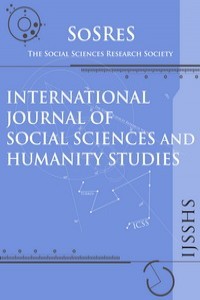A RESEARCH ABOUT EMPLOYEES' WORK-LIFE BALANCE AND PRESENTEEISM TENDENCY
A RESEARCH ABOUT EMPLOYEES' WORK-LIFE BALANCE AND PRESENTEEISM TENDENCY
Work-Life Balance, Presenteeism Tendency, Productivity,
___
- Baker-McClearn, D., Greasley, K., Dale, J. and Griffith, F. (2010) ‘Absence management and presenteeism: the pressures on employees to attend work and the impact of attendance on performance’. Human Resource Management Journal 20: 3, 311–328.
- Bierla, I, Huver, B. and Richard, S., 2013. New evidence on absenteeism and presenteeism, The International Journal of Human Resource Management, Vol. 24, No. 7, 1536–1550.
- Cancelliere, C., Cassidy, J.D., Ammendolia, C. and Côté, P. 2011. Are workplace health promotion programs effective at improving presenteeism in workers? A systematic review and best evidence synthesis of the literature, BMC Public Health 2011, 11:395 http://www.biomedcentral.com/1471-2458/11/395
- Ferreira, A.I. and Martinez, L.F., 2012. Presenteeism and burnout among teachers in public and private Portuguese elementary schools, The International Journal 10.1080/09585192.2012.667435 Resource Management, 23:20, 4380-4390, DOI:
- Ghalawat and Sukhija, 2012. Work-Life Balance and organization Prectices- A Study of Selected Banks in Sirsa, BVIMR Management Edge, Vol. 5, No:2, pp.35-44.
- Johns, G., 2009. Presenteeism in the workplace: A review and research agenda,
- Journal of Organizational Behavior, Wiley InterScience, 519–542.
- Karthic, R., 2013. A Study on Work-Life Balance in Chennai Port Trust, Chennai, Advances In Management Vol. 6 (7)
- McShane, S.L and Glinow, M.A.V, 2010. Organizational Behavior, McGraw- Hill/Irvin, 5th Edition. ISBN 978-0-07-338123-7.
- Schultz, A.B, Chen, C.Y. and Edington, D.W., 2009. The Cost and Impact of Health Conditions Pharmacoeconomics 2009; 27 (5): 365-378. to Employers a Review of the Literature,
- http://dictionary.reference.com (09.08.2013)
- http://dictionary.cambridge.org (06.08.2013)
- http://www.collinsdictionary.com (01.06.2013)
- Başlangıç: 2009
- Yayıncı: Sosyal Bilimler Araştırmaları Derneği
ATTITUDES TOWARDS ENVIRONMENTAL ISSUES: A CASE OF BOPHELONG TOWNSHIP
Ismael Maloma, Mmapula Brendah Sekatane
CORRELATION BETWEEN INTELLECTUAL CAPITAL AND WEB TRENDS OF TOP 30 COMPANIES IN TURKEY
Cevdet Kızıl, M. Lütfi Arslan, Sadi Evren Seker
SOCIAL CAPITAL IN INVOLUNTARY DISPLACEMENT AND RESETTLEMENT
Melissa Quetulio Navarra, Anke Niehof, Wander van der Vaart
SECURITY THREATS IN CENTRAL ASIA
SOCIAL INTEGRATION: TESTING ANTECEDENTS OF TIME SPENT ONLINE
Lily Suriani Mohd Arif, Osman B. Gazzaz, Fazal Rahi, m Khan
THE IMPACT OF EMPLOYMENT WEB SITES’ TRAFFIC ON UNEMPLOYMENT: A CROSS COUNTRY COMPARISON
M. Lütfi Arslan, Sadi Evren Seker
A RESEARCH ABOUT EMPLOYEES' WORK-LIFE BALANCE AND PRESENTEEISM TENDENCY
